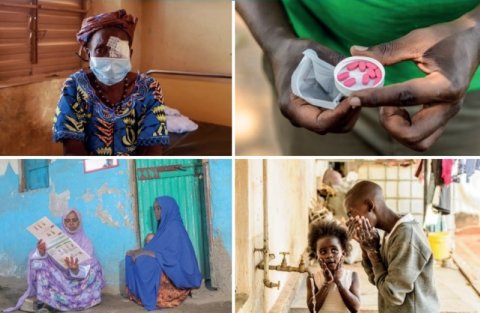International Health supplement on trachoma published as part of Sightsavers dissemination partnership

We have published a new research supplement in our journal International Health that provides updates on the infectious eye disease trachoma, in partnership with Sightsavers.
The supplement, 'Trachoma: Accelerating progress to elimination as a public health problem', focuses on Sightsavers’ programmes to eliminate this painful and debilitating disease.
Roughly 115 million people around the world are at risk from trachoma, which can cause permanent blindness if left untreated.
The papers in the supplement show how African countries are using innovative approaches to work towards the elimination of trachoma, supported by international NGOs such as Sightsavers and funding partners such as the Audacious donor group.
We’re proud to have worked with RSTMH to launch this new collection of research, which includes practical learnings from years of programme implementation. These learnings can help governments and their partners to overcome the final hurdles in the fight against trachoma.
“This disease can have a devastating impact for individuals, their families and for society as a whole – but it can be beaten. If the global community works together, we can go down in history as the generation that eliminates trachoma as a public health problem around the world.”
Caleb Mpyet, Sightsavers’ global technical lead for trachoma
On 23 January, RSTMH and Sightsavers are hosting an online event where experts will share the key learnings around how trachoma can be eliminated. Attendees will have the chance to discuss the research findings during a series of Q&A sessions. You can register for the event here.
This supplement forms part of a three-year partnership, in which RSTMH has been using its scientific journals and other communications channels to help disseminate the key outputs and learnings from Sightsavers’ lead programmes. The hope is that this will inspire others to take strides towards, or continue in their efforts in eliminating NTDs, strengthening healthcare systems and ensuring no one is left behind.
We are delighted to publish our third supplement as part of our partnership with Sightsavers.
“We are excited to be able to share this research with our networks. 115 million people are at risk of trachoma and we hope this research supplement helps support the fight against Trachoma.”
Tamar Ghosh, RSTMH CEO
Articles in the supplement are:
- Editorial: Addressing the challenges of reaching trachoma elimination: leveraging on lessons learnt from programme implementation. Caleb Mpyet and others.
- High prevalence of trachomatous inflammation–follicular with no trachomatous trichiasis: can alternative indicators explain the epidemiology of trachoma in Côte d’Ivoire? Kareen Atekem and others
- Treatment coverage of mass administration of azithromycin among children aged 1–11 months in 21 districts of Kebbi state, Nigeria. Teyil Wamyil-Mshelia and others
- Comparing image quality and trachoma detection across three camera types from a survey in Kongwa, Tanzania. Ugochi T Aguwa and others.
- Expanding a photographic grading system for trachomatous scarring. Yassin Nayel and others.
- Prevalence of trachoma in Somali region, Ethiopia: results from trachoma impact surveys in 50 woredas. Getachew Gebreselassie and others.
- Motivating school communities towards behavior change and local ownership: a gamification intervention to prevent trachoma at primary schools in southern Ethiopia. Naomi Caplan and others.
- Explaining the continuing high prevalence of trachomatous trichiasis unknown to the health system in evaluation units: a mixed methods explanatory study in four trachoma-endemic countries. Grace Mwangi and others.
- A secondary analysis to determine countries and districts eligible for documented full geographic coverage for trichiasis case finding and outreaches. Michael K Kamuyu and others.
- Gender differences in the surgical management of trachomatous trichiasis: an exploratory analysis of global trachoma survey data, 2015–2019. Kristin M Sullivan and others.
- ‘Follow the cattle’: a joint cross-border trachoma MDA perspective. Gilbert Baayenda and others.
- Improving data use in trachomatous trichiasis programmes: operationalisation of the TT Tracker. Sarah Bartlett and others.
